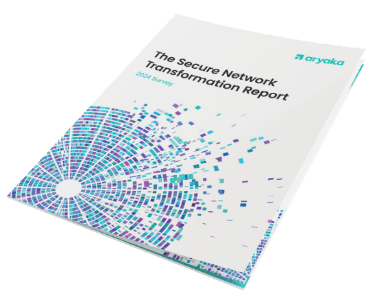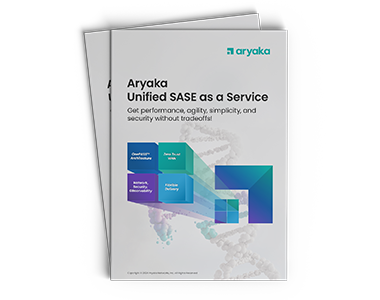How to Choose the Right SASE Model

With emerging threats already on the rise, the upheaval caused by the global pandemic creates the perfect storm for cybersecurity. The market is flooded with security solutions, yet more new tools are being released yearly. This influx exacerbates the challenges faced by organizations.
Secure Access Service Edge (SASE) is at the forefront of the network security market, offering a consolidated solution encompassing multiple networking and security tools. Buyers have embraced its benefits. However, many SASE vendors provide limited flexibility in their solutions. Unfortunately, cookie-cutter security does not suffice. At Aryaka, we assist organizations in maximizing cyber protection by leveraging existing tools or further consolidating them with our natively built Unified SASE solution.
In this article, I will delve into the complexities of cybersecurity, elucidate the benefits of SASE for organizations, and provide guidance on selecting the appropriate SASE model, regardless of your stage in the SASE journey.
Why is cybersecurity so hard and getting even harder?
After decades of effort and trillions of dollars invested, organizations continue to grapple with cyber-attacks. As a security practitioner, you’ve likely heard the saying, “As defenders, we must be right 100 percent of the time, while attackers need only succeed once.” Once infiltrated, attackers can inflict severe damage on your network and environment. In the cybersecurity world, we face this asymmetrical battle which has always been a never-ending race.
Unfortunately, the challenges are getting worse, and it has been driven mainly by the following four trends:
The security tool sprawling
According to Telegeography, international internet capacity has increased by 28% in 2022. It drives up the need for security solutions even more drastically. Currently, organizations are generally burdened with managing approximately 76 security tools, which presents a significant challenge. The sheer volume of diverse siloed security tools, coupled with a lack of native interoperability between them, remains one of the most prominent obstacles confronting cybersecurity operations today.
The increasing complexity of today’s hybrid work environment
With the ongoing digital transformation process, we are witnessing a surge in the migration of applications from private data centers to the cloud. As a result, the traditional perimeter-based security approach has become obsolete. Moreover, the pandemic has expedited the existing trend of remote work. Collectively, these factors introduce greater complexity to your network and expand the attack surface within your environment.
Increasing sophisticated threats
At the same time, the landscape of threat actors has evolved beyond individual entities. We are witnessing a rise in highly sophisticated organizations or nation-state-sponsored threat actors employing advanced tools powered by artificial intelligence and machine learning. Consequently, the magnitude of the threat is expanding, and no one is immune. For any enterprise, the question of whether a security breach will happen is no longer “if” but “when.” Therefore, organizations must adopt a proactive mindset, assuming a breach will occur, and have centralized visibility and policy control over their entire network to ensure effective response and mitigation measures.
Cybersecurity Talent Shortage
According to the 2022 Cybersecurity Workforce Study (ISC2), there is a global shortage of skilled cybersecurity professionals, with a need for an additional 3.4 million professionals. This skills gap has more than doubled since 2019, and the trend is expected to continue in 2023. In light of this shortage, focusing solely on the right security technology is no longer sufficient. Organizations must also seek vendor support and acquire security expertise to address their cybersecurity challenges effectively.
If you attended the RSA conference this year, you likely observed the widespread presence of the acronym SASE (Secure Access Service Edge). But what exactly is SASE, and how does it help protect organizations in today’s cybersecurity landscape?
What is SASE, and why is it crucial in today’s modern work environment?
According to Gartner and Dell’ Oro, SASE combines SD-WAN and network security services, including firewalls, SWGs, CASB, and ZTNA (zero trust network access), into a single vendor solution. The nature of SASE consolidates networking and network security not just eliminates the architecture complexity but also lowers the operation cost by reducing the number of point solutions organizations must manage.
Traditional network security architectures are insufficient to provide the required protection and performance in today’s modern world, characterized by highly distributed users and applications across the Internet. To be effective, network security must be integrated into the network architecture rather than a bolt-on component as an afterthought. This integration allows security policies to enhance the network posture inherently. The SASE (Secure Access Service Edge) solution is designed precisely for this purpose. The network and security policies must be centrally managed in the cloud and enforced at the network edges, close to resources or users, as much as possible. This contrasts legacy firewall or appliance-based solutions that funnel all traffic to a centralized data center for inspection.
Unified SASE vs. Multivendor SASE
Based on the implementation model, SASE solutions can be classified into two categories: Unified SASE and Multivendor SASE.
Unified SASE involves integrating natively built security and networking capabilities into a single platform, which is managed through a unified management portal. This approach provides IT administrators with a single pane of glass, enabling them to quickly address issues and implement remediation measures from a central location, eliminating the need to navigate between multiple management consoles. Unified SASE also tackles the challenge of tool sprawl by reducing the number of solutions that organizations need to manage. Additionally, it offers seamless interoperability between security and networking functions, enhancing the overall security posture, reducing architectural complexity, and potentially leading to lower costs and improved performance.
On the other hand, Multivendor SASE comprises separate networking components (e.g., SD-WAN) and security products and services (e.g., firewalls, SWGs, etc.) integrated into a complete SASE solution. These networking and security products may originate from the same or different vendors. Integrating third-party networking and security technologies into the solution is generally more straightforward, as it does not require vendors to rewrite the code for their solutions. This allows organizations to start their SASE journey without discarding their existing service contracts, enabling them to leverage their existing investments.
How to Choose the Right Service to Kick Off Your SASE Journey?
To fully leverage the benefits of SASE, organizations should strongly consider adopting a Unified SASE solution from a single vendor. However, the process of replacing multiple network or network security solutions can be a daunting task. That is why it is crucial to select a SASE vendor that also offers migration services to help alleviate the operational burden associated with the transition.
However, it is important to acknowledge that organizations may need to follow a phased approach when adopting the full Unified SASE solution. Aligning subscription terms and appliance refresh cycles across multiple solutions can introduce delays in the SASE adoption timeline. Justifying the OpEx or CapEx to terminate existing service contracts or accelerate the appliance refresh cycle can also present additional challenges.
In such cases, organizations should consider a multi-vendor SASE approach. This involves replacing one or a few solutions at a time and gradually transitioning to a unified SASE solution from a single vendor. However, when evaluating the multi-vendor SASE approach, organizations should also give due consideration to the importance of managed services. Managed services can help alleviate the operational burden associated with ensuring interoperability among different components. Neglecting this aspect could potentially undermine the advantages offered by SASE.
Conclusion
Unified SASE and Multivendor SASE each have their own advantages and disadvantages. Unified SASE offers greater architectural efficiency, while Multivendor SASE provides increased flexibility. Aryaka is unique in offering both Unified and Multivendor SASE options, catering to customers at different stages of their SASE journey. Furthermore, Aryaka not only provides SASE solutions as a technology vendor but also serves as a managed service provider, helping businesses alleviate operational burdens and address staffing challenges.
In my upcoming blog, I will delve into what sets our Unified SASE solution apart. Stay tuned for more information.




